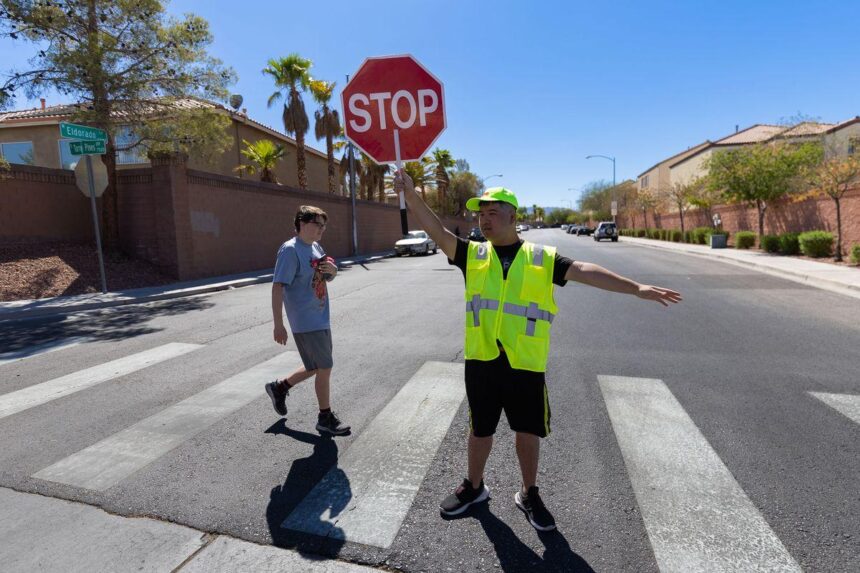Las Vegas Enhances Student Safety with New Crossing Guard Program at Secondary Schools
City Council Launches Initiative to Protect Students and Manage Traffic
In a proactive move to safeguard students and alleviate congestion during school hours, the Las Vegas City Council has authorized the recruitment of crossing guards at secondary schools citywide. This decision responds to mounting concerns from parents, educators, and community advocates regarding pedestrian hazards in areas with heavy traffic near middle and high schools. The program aims to provide reliable assistance for students navigating busy streets,promoting safer commutes to and from school.
Focused Deployment of Crossing Guards to Reduce Traffic Risks
To effectively minimize traffic-related dangers, the city has earmarked funds to station trained crossing guards at critical school zones. These personnel will be strategically positioned at intersections identified through comprehensive safety evaluations conducted alongside school officials and traffic specialists. Their presence is intended to lower the incidence of accidents and create a secure habitat for students traveling on foot or by bicycle.
Highlights of the Program Include:
- Guard deployment during peak arrival and dismissal times to facilitate safe pedestrian crossings
- Ongoing professional growth and safety training for crossing guards
- Partnerships with local law enforcement to monitor and address traffic violations near schools
- Community outreach initiatives to increase awareness about pedestrian safety
| School | Number of Guards | Coverage Hours |
|---|---|---|
| Clark High School | 4 | 7:30 AM – 8:15 AM, 2:45 PM – 3:30 PM |
| West Career & Technical Academy | 3 | 7:45 AM – 8:30 AM, 3:00 PM – 3:45 PM |
| Basic High School | 5 | 7:20 AM – 8:10 AM, 2:50 PM – 3:40 PM |
Data-Driven Placement of Crossing Guards for Maximum Impact
The selection of crossing guard locations is grounded in detailed analysis of traffic patterns, pedestrian flow, and historical accident data. Priority is given to intersections with high vehicle volumes during school hours, ensuring guards are stationed where students face the greatest risks. Key focus areas include:
- Intersections near school entrances with heavy pedestrian activity
- Crosswalks frequently used by students but lacking traffic signals
- Stops for public transit commonly utilized by teenagers
Deployment schedules are tailored to cover critical times such as morning arrival,lunch periods,and dismissal,optimizing guard presence when it is most needed. This targeted strategy not only enhances safety but also builds community trust in school zone security measures.
| Criteria | Influence on Placement (%) |
|---|---|
| Student Pedestrian Volume | 35% |
| Vehicle Traffic Density | 30% |
| Historical Incident Frequency | 20% |
| Proximity to Public Transportation | 15% |
Community Feedback and Anticipated Benefits of the Safety Program
Local parents and advocacy organizations have welcomed the council’s decision, emphasizing the vital role crossing guards play in protecting students. Many believe that having trained personnel at busy intersections will considerably reduce accidents and foster a safer environment for children walking or biking to school. There is also optimism that this initiative will encourage further improvements in pedestrian infrastructure, such as enhanced signage and refreshed crosswalk markings.
Community members have expressed the need for consistent program oversight and effective implementation. Key requests include:
- Regular refresher training to maintain guard vigilance and responsiveness
- Transparent reporting on incident statistics and guard deployment
- Ongoing collaboration with school officials to adjust crossing points as necessary
Projected outcomes for the first year of the program are summarized below:
| Metric | Before Program | Expected After Program |
|---|---|---|
| Pedestrian-Related Accidents | 12 annually | 5 annually |
| Community Satisfaction | 68% | 90% |
| Student Commute Stress | High | Moderate |
Looking ahead, the community anticipates that these measures will not only improve daily safety but also cultivate a culture of awareness and responsibility among students and residents.
Best Practices for Sustaining and Evaluating the Crossing Guard Program
For the crossing guard initiative to achieve lasting success, comprehensive training must extend beyond basic traffic control. Guards should be proficient in conflict management and first aid to handle emergencies effectively. Regular workshops and refresher courses will help maintain high standards and uniformity across all school zones. Additionally, involving parents, educators, and law enforcement in periodic program reviews will foster continuous improvement and strengthen community confidence.
Essential Elements for Program Monitoring:
- Real-time feedback via mobile applications to report concerns or suggest enhancements
- Quarterly evaluations assessing guard punctuality, attentiveness, and communication
- Biannual analysis of traffic incident data to measure program effectiveness
- Monthly community forums to ensure openness and stakeholder involvement
| Monitoring Tool | Objective | Frequency |
|---|---|---|
| Mobile App Feedback | Immediate performance insights | Ongoing |
| Performance Reviews | Assess guard effectiveness | Quarterly |
| Incident Data Review | Track accident reduction | Every 6 months |
| Community Meetings | Promote transparency and dialogue | Monthly |
Summary: Advancing Student Safety Through Community Collaboration
The Las Vegas City Council’s endorsement of a dedicated crossing guard program for secondary schools represents a significant advancement in protecting young pedestrians. As the initiative rolls out, officials stress the importance of ongoing community partnership to maintain a secure environment for students. This program underscores the city’s commitment to addressing traffic safety challenges near educational institutions and will be supplemented with updates on staffing and deployment as progress continues.









